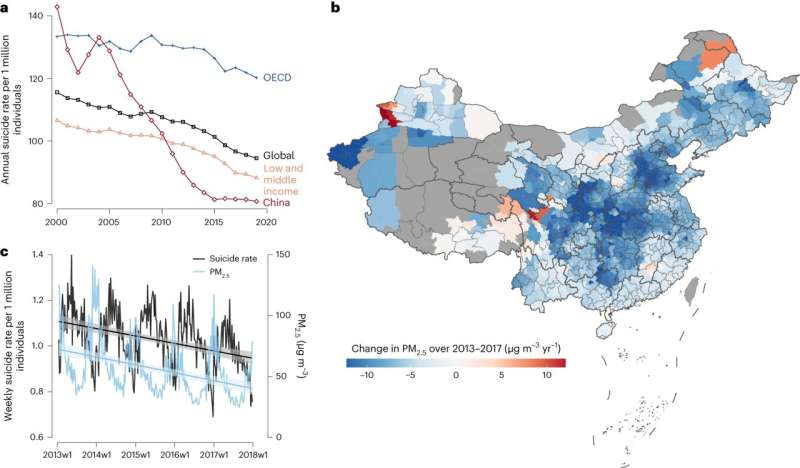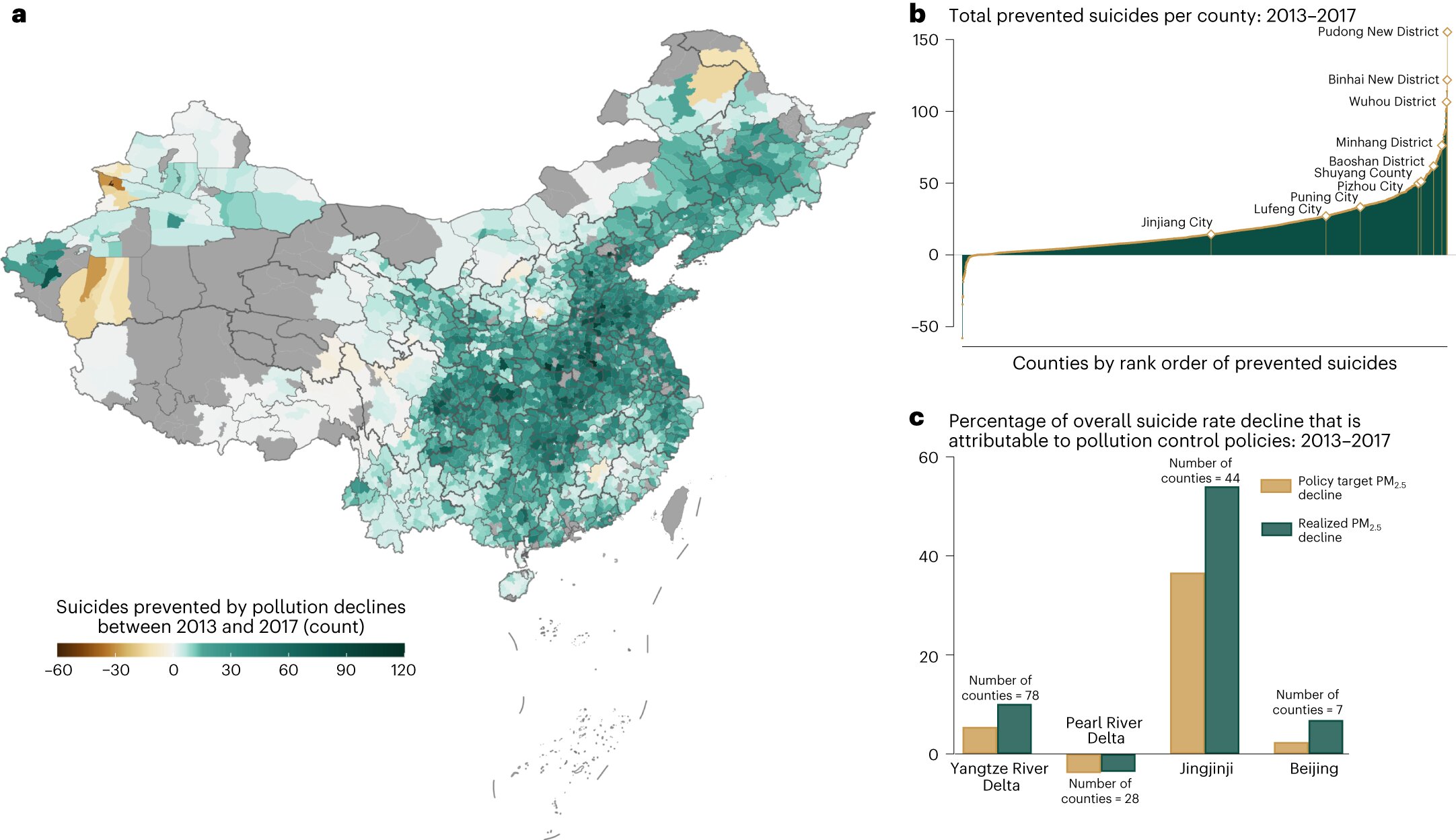Researchers in the United States and China have discovered a curious link between air pollution and suicide rates that prompts us to reconsider how to approach this issue. China’s efforts to reduce air pollution have prevented 46,000 suicide deaths in the country over just five years, the researchers estimate. The team used weather conditions to tease apart confounding factors affecting pollution and suicide rates, arriving at what they consider to be a truly causal connection.
The results, published in Nature Sustainability, unearth air quality as a key factor influencing mental health.
Issues like air pollution are often framed as a physical health problem leading to a spectrum of acute and chronic illnesses such as asthma, cardiovascular disease and lung cancer. But co-lead author Tamma Carleton, an assistant professor at UC Santa Barbara’s Bren School of Environmental Science & Management, knows these environmental factors can take a toll on mental health as well. She’s previously studied the effect of temperature on suicide rates in India, finding that excessive heat drives those rates up.
She was curious when she noticed the rate in China dropping far faster than its decline in the rest of the world. In 2000, the country’s per-capita suicide rate was higher than global average; two decades later it has fallen below that average, which itself is declining.
At the same time, air pollution levels were plummeting. “It’s very clear that the war on pollution in the last seven to eight years has led to unprecedented declines in pollution at a speed that we really haven’t seen anywhere else,” said Carleton. Perhaps these two phenomena were related, Carleton thought.
Carleton and co-lead author Peng Zhang, a former UCSB doctoral student, teamed up with researchers in Xanghai and Beijing to examine the effects of China’s recent crackdown on air pollution on suicide rates across the country. They gathered demographic data from 2013 through 2017 from the Chinese Center for Disease Control and Prevention and meteorological data from the China Meteorological Data Service Center.
The team faced a tricky task.
“One of the bigger challenges with prior work on this problem is that air pollution is correlated with a lot of things,” said Carleton. For instance, economic activity, commuting patterns, even industrial output correlate with pollution. And these activities can also affect suicide rates. “Our goal was to isolate just the role of pollution on suicide as opposed to all the other things that might be correlated with air pollution.”
To this aim, they took advantage of an atmospheric condition called an inversion, where warm air traps a layer of cold air beneath it like a lid on a pot. This can concentrate air pollution near the surface, leading to days with higher pollution levels that aren’t correlated with human activity. This relatively random phenomenon enabled Carleton, Zhang and their co-authors to isolate the effects of air pollution on suicide rates. By decoupling pollution levels from human activity—which influences human behavior—the authors believe they’ve truly identified a causal effect.

The team compared suicide numbers across 600 counties between weeks with inversions and those with more typical weather, running the data through a statistical model. “Suicide rates increase substantially when air pollution rises,” the authors found. The effect was particularly strong for elderly people, with older women 2.5 times more vulnerable than other groups.
The authors aren’t certain why older women are especially vulnerable to this effect, though it may be partly cultural. Previous research suggests that most suicides by women in China are driven by acute crises. So if pollution has an acute effect on mental health, it could disproportionately impact older women.
And the phenomenon does appear to happen relatively quickly. Rates increase within the first week of exposure, and then abruptly decline once conditions improve. This suggests that pollution may have a direct neurologic effect, rather than creating chronic health issues that drive suicide rates up later on. Indeed, there is growing evidence that particulate pollution affects neurochemistry.
Pollution is not the only environmental factor influencing suicide rates, but Carleton said it packs a punch. “Thirty years of warming in India led to about the same magnitude of suicide effects as about five years of air pollution control in China,” she explained.
“We often think about suicide and mental health as a problem to be understood and solved at an individual level,” she continued. “This result points to the important role of public policy, of environmental policy, in mitigating mental health and suicide crises outside of individual-level intervention.”
She hopes the findings can reframe how society approaches suicide prevention. “Public policy about air pollution—something you can’t control, what’s outside your window—is affecting the likelihood that you take your own life. And I think that puts a different lens on the solutions we should be thinking about,” Carleton said. “It’s important that public health officials also know this as our climate gets warmer, and as pollution increases in many developing countries.”
Carleton plans to take a closer look at suicide rates in other Southeast Asian nations. Most suicide research has been conducted in the U.S. and Europe, she explained. It’s less clear what drives suicide in the developing world, which is also where we’re seeing the most rapid environmental change.
Of course, pollution is not the only factor that can lead a person to end their life. “About 10% of the overall decline over these past five years can be attributed to particulate pollution,” Carleton said. “That’s important, but it also leaves 90% unexplained by pollution.”
There are many reasons to control pollution around the world, and now suicide can be added to the conversation. China’s aggressive, successful policies achieved dramatic results in a short timeframe, serving as a potential model for other countries struggling with pollution and helping to reframe discussion about suicide in the modern world.
More information:
Peng Zhang et al, Estimating the role of air quality improvements in the decline of suicide rates in China, Nature Sustainability (2024). DOI: 10.1038/s41893-024-01281-2
Citation:
Better air quality is linked to reduced suicide rates, study finds (2024, February 28)
retrieved 28 February 2024
from https://phys.org/news/2024-02-air-quality-linked-suicide.html
This document is subject to copyright. Apart from any fair dealing for the purpose of private study or research, no
part may be reproduced without the written permission. The content is provided for information purposes only.


